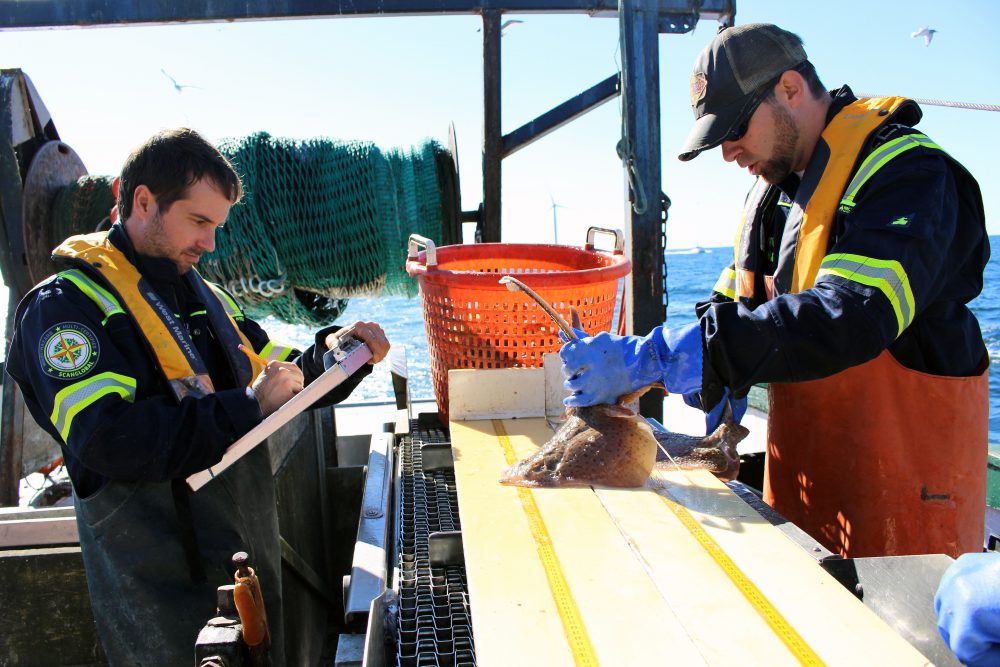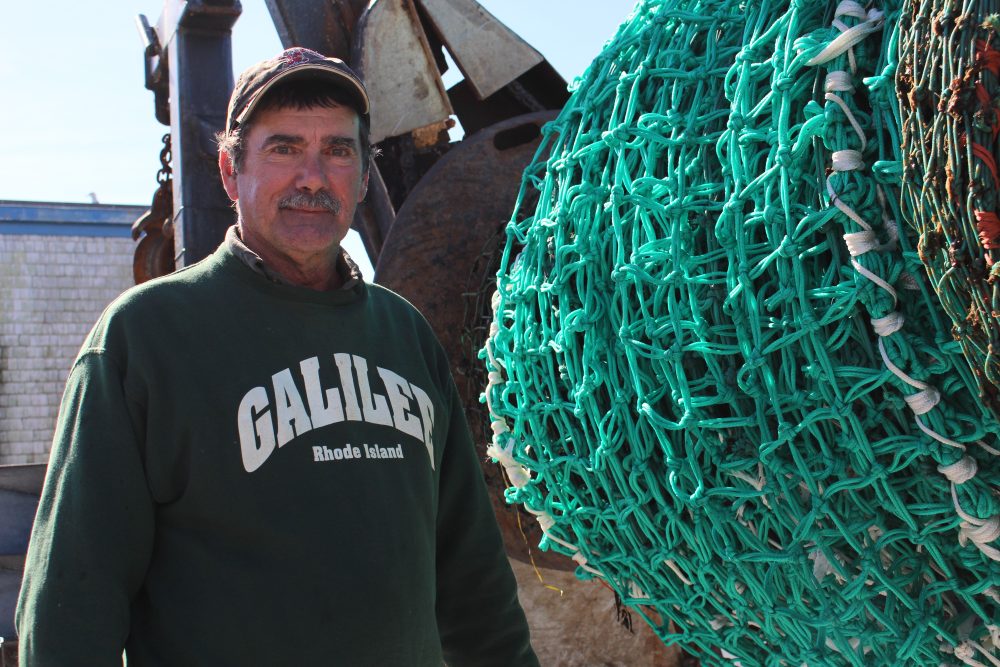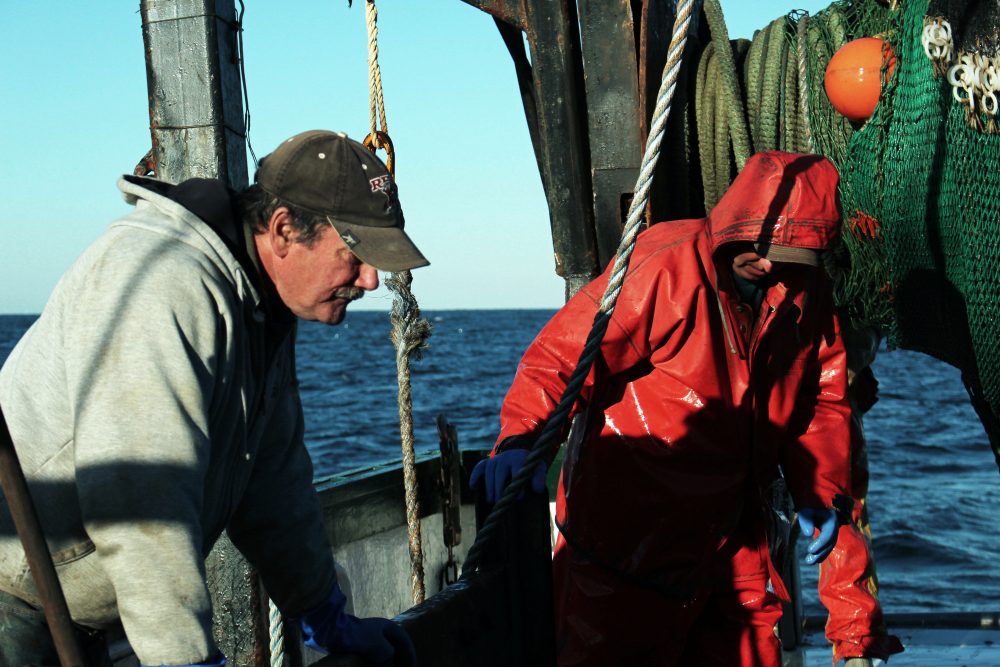Advertisement
How Rhode Island's Offshore Wind Farm Affects Fishermen
Resume
Every month for the past four and a half years, Captain Rodman Sykes has sailed out to the Block Island Sound, off of Rhode Island, with his crew and a small group of scientists.
They tow a fish net and scrape the seafloor twice in three different locations within the area of the Block Island Wind Farm, and in areas close to it, for reference.
"Mostly skates, there’s a sea bass and a few small scup, sea robins, dogfish," Sykes says aloud as he stands over the fish to inspect them each time his crew brings up the net and releases the catch. "Not much else, but a good sample. So we’ll go on to the next station."
While Sykes redirects his vessel to the next sampling area, scientists get right to work sorting fish by species, taking their weight and measuring their length.
Together these scientists and fishermen make up the research team hired by Deepwater Wind to collect data to understand what a wind farm would do to fish and shellfish in the area.
The nation's first offshore wind farm is set to start producing electricity any day now. It’s a pilot project that will change the way the people on that small island power their homes and businesses. But it may also change fishing in the area surrounding the turbines.

Sykes says at first that didn’t sit well with the small group of fishermen.
“I had guys question me about, ‘Why are you working for the wind farm?’ ” recalls Sykes. “I told them, ‘I am not working for the wind farm, I am working for the fishing community.’ ”
Deepwater Wind hired fishermen to be a part of this research survey to get their buy-in. It worked. Sykes thinks this partnership between scientists and local fishermen is important.
“We don’t want some out-of-state boat -- we don’t want a government or state boat doing it,” Sykes said. “We need one of our boats to do it to have the trust of the fishermen.”
As a longtime commercial fisherman for nearly 50 years, Sykes knows these waters well. Fishermen respect him, so he’s kind of like the fishing community’s eyes and ears on this project.
Inspire Environmental, the firm overseeing the research trawl survey, tapped into the expertise of local fishermen to design the study: to learn where they drag their nets, how fish move in the area and what kind of concerns they have.
“But we also designed a very robust scientific study,” says Drew Carey, a principal scientist at the firm, “so that both the regulators and the academic scientists would be satisfied that the results from the first offshore wind farm in the nation could be useful and applied to other projects that are on the drawing board right now.”
Carey says they collected data during the most disruptive construction periods. He and Sykes both say they haven’t seen anything that indicates negative changes to the fish and lobsters around the turbines. It’s too early to see trends. But the turbine foundations have already become artificial reefs.

On another boat that gave a tour of the offshore wind farm this summer, Grover Fugate, executive director of the Rhode Island Coastal Resources Management Council, tells visitors the foundations the turbines sit on about an inch and a half layer of mussels that are attracting more fish.
“We were out here several time with the work crews and you put the fish finders on and you could see these column of fish up and down underneath the towers,” Fugate says. “The other interesting thing is -- in speaking to other fishermen — is that the fish species that you see under each tower seem to differ. So it seems like each tower has its own little community that’s a little different than the others.”
But some fishermen are still skeptical. Back on the boat where fish data are being gathered, Anthony Ponte is one of them. He, too, hasn't seen any negative impacts so far.
“But you don’t know what’s gonna happen once electricity starts flowing through the wires,” he says.
Sykes adds that fishermen feel like there are still a lot of unknowns about how a new energy industry will affect theirs.
“This of course is only the beginning,” Sykes says. “If this works out, they are just going to be more and more and more. How much of the ocean are they going to take away from us? We’ve basically have the ocean to ourselves for forever. And now the ocean is starting to be divided up and that’s a hard thing to accept. But they gotta realize that someday someone is going to say, ‘Wait a minute, I want some of that.’ ”
This research project that Sykes is a part of will continue to gather data for two years while the wind farm is in operation. That ought to give Rhode Island and other states a better understanding of what fishing impacts to expect from an emerging offshore wind industry.
This segment aired on November 28, 2016.